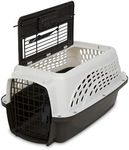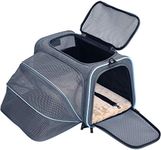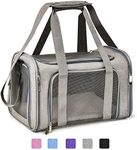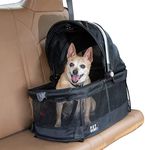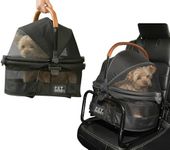Buying Guide for the Best Cat Carriers
Choosing the right cat carrier is important for both your pet’s comfort and your own convenience. A good carrier keeps your cat safe and secure during trips to the vet, travel, or emergencies. When shopping for a cat carrier, you should consider your cat’s size, temperament, and how you plan to use the carrier. The right carrier will make travel less stressful for both you and your feline friend.Size and DimensionsSize and dimensions refer to the overall space inside the carrier. This is important because your cat needs enough room to stand, turn around, and lie down comfortably. Carriers come in small, medium, and large sizes. Small carriers are best for kittens or petite cats, medium for average-sized adult cats, and large for bigger breeds or if you want extra space. To pick the right size, measure your cat’s length and height, and add a few inches for comfort. If your cat is anxious or likes to stretch out, a slightly larger carrier may be better.
Material and ConstructionMaterial and construction describe what the carrier is made of and how sturdy it is. Carriers are usually made from hard plastic, soft fabric, or a combination of both. Hard-sided carriers offer more protection and are easier to clean, making them good for nervous or strong cats. Soft-sided carriers are lighter and more comfortable to carry, but may not be as secure for escape-prone cats. Choose a material based on your cat’s behavior and how often you’ll use the carrier.
VentilationVentilation means how much fresh air can flow into the carrier. Good ventilation is important to keep your cat cool and comfortable, especially during longer trips. Carriers with mesh panels or multiple openings provide better airflow. If your cat gets hot easily or you live in a warm climate, look for carriers with plenty of ventilation. For short trips in cooler weather, less ventilation may be acceptable.
Entry PointsEntry points are the doors or openings through which you place your cat in the carrier. Some carriers have a single front door, while others offer top-loading or side-loading options. Top-loading carriers make it easier to place a reluctant or scared cat inside. If your cat is calm, a front or side entry may be enough. Consider your cat’s temperament and how easy it is to handle them when choosing the type of entry.
Portability and HandlesPortability and handles refer to how easy it is to carry the carrier. Features like padded handles, shoulder straps, or wheels can make transport more comfortable for you. If you’ll be carrying the carrier for long distances or through crowded places, look for ergonomic handles or straps. For quick car trips, basic handles may be sufficient.
Ease of CleaningEase of cleaning is about how simple it is to keep the carrier hygienic. Accidents can happen, so carriers with removable and washable pads or liners are helpful. Hard-sided carriers are usually easier to wipe down, while soft-sided ones may have machine-washable parts. If your cat is prone to messes or you want to keep things sanitary, prioritize carriers that are easy to clean.
Security FeaturesSecurity features include locks, zippers, and latches that keep the carrier closed and your cat safely inside. Some cats are escape artists, so sturdy locks and escape-proof designs are important. If your cat is calm, basic closures may be enough, but for active or anxious cats, look for extra-secure fastenings.


